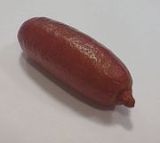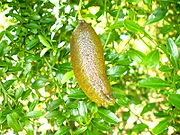
Finger Lime
Encyclopedia
The Finger Lime plant, Citrus australasica (syn. Microcitrus australasica) is a thorny understorey shrub
or small tree
of lowland subtropical rainforest
and dry rainforest in the coastal border region of Queensland
and New South Wales
, Australia
.
The plant is 2-7 meters in height. Leaves are small, 1-6 cm long and 3-25 mm wide, glabrous, with a notched tip and crenate towards the apex. Flowers are white with petals 6-9 mm long. The fruit
is cylindrical, 4-8 cm long, sometimes slightly curved, coming in different colours, including pink and green.
The finger lime has been recently popularised as a gourmet bushfood
. The globular Juice vesicles
have been likened to a "caviar lime", which can be used as a garnish or added to various recipes. The fresh vesicles have the effect of a burst of effervescent tangy flavour as they are chewed. The fruit juice is acidic and similar to that of a lime. Marmalade
and pickles
are also made from finger lime. The finger lime peel can be dried and used as a flavouring spice
.
There is a wide range of different coloured variants of finger lime fruit, including green, yellow, orange, red, purple, black and brown. Finger lime is thought to have the widest range of colour variation within any Citrus
species.
Commercial use of finger lime fruit started in the mid-1990s in boutique
marmalades made from wild harvested fruit. By 2000 the finger lime was being sold in restaurants, including the export of fresh fruit.
 The finger lime has been recently grown on a commercial basis in Australia in response to high demand for the fruit. There is an increasing range of genetic selections which are budded onto Citrus rootstock. With the sudden high market demand for the fruit the primary source of genetic material for propagation has been selections from wild stock.
The finger lime has been recently grown on a commercial basis in Australia in response to high demand for the fruit. There is an increasing range of genetic selections which are budded onto Citrus rootstock. With the sudden high market demand for the fruit the primary source of genetic material for propagation has been selections from wild stock.
In cultivation, the finger lime plant is grown in much the same way as other citrus species. It may be subject to some pests and diseases requiring pest control in cropping situations. This includes scale, caterpillars, gall-wasp, and limb dieback
. Research into fruit fly by Dr Andrew Jessop has concluded that Finger Limes are a non-host plant to fruit flies and as such are not a quarantine risk to importing countries.
Research conducted in the 1970s indicated that a wild selection of C. australasica was highly resistant to Phytophthora
citrophthora root disease, which has resulted in a cross-breeding program with finger lime to develop disease-resistant citrus rootstock
.
The CSIRO has also developed several Citrus hybrids by crossing the finger lime with standard Citrus species.
Shrub
A shrub or bush is distinguished from a tree by its multiple stems and shorter height, usually under 5–6 m tall. A large number of plants may become either shrubs or trees, depending on the growing conditions they experience...
or small tree
Tree
A tree is a perennial woody plant. It is most often defined as a woody plant that has many secondary branches supported clear of the ground on a single main stem or trunk with clear apical dominance. A minimum height specification at maturity is cited by some authors, varying from 3 m to...
of lowland subtropical rainforest
Rainforest
Rainforests are forests characterized by high rainfall, with definitions based on a minimum normal annual rainfall of 1750-2000 mm...
and dry rainforest in the coastal border region of Queensland
Queensland
Queensland is a state of Australia, occupying the north-eastern section of the mainland continent. It is bordered by the Northern Territory, South Australia and New South Wales to the west, south-west and south respectively. To the east, Queensland is bordered by the Coral Sea and Pacific Ocean...
and New South Wales
New South Wales
New South Wales is a state of :Australia, located in the east of the country. It is bordered by Queensland, Victoria and South Australia to the north, south and west respectively. To the east, the state is bordered by the Tasman Sea, which forms part of the Pacific Ocean. New South Wales...
, Australia
Australia
Australia , officially the Commonwealth of Australia, is a country in the Southern Hemisphere comprising the mainland of the Australian continent, the island of Tasmania, and numerous smaller islands in the Indian and Pacific Oceans. It is the world's sixth-largest country by total area...
.
The plant is 2-7 meters in height. Leaves are small, 1-6 cm long and 3-25 mm wide, glabrous, with a notched tip and crenate towards the apex. Flowers are white with petals 6-9 mm long. The fruit
Fruit
In broad terms, a fruit is a structure of a plant that contains its seeds.The term has different meanings dependent on context. In non-technical usage, such as food preparation, fruit normally means the fleshy seed-associated structures of certain plants that are sweet and edible in the raw state,...
is cylindrical, 4-8 cm long, sometimes slightly curved, coming in different colours, including pink and green.
Cultivation and Uses
Early non-indigenous settlers consumed the fruit and retained the trees when clearing for agriculture. Colonial botanists suggested that they should be cultivated.The finger lime has been recently popularised as a gourmet bushfood
Bushfood
Bushfood traditionally relates to any food native to Australia and used as sustenance by the original inhabitants, the Australian Aborigines, but it is a reference to any native fauna/flora that is used for culinary and/or medicinal purposes regardless of which continent or culture it originates...
. The globular Juice vesicles
Juice vesicles
The juice vesicles of a citrus fruit are the membranous content of the fruit’s endocarp. The vesicles contain the juice of the fruit. The pulp is usually removed from the juice by filtering it out...
have been likened to a "caviar lime", which can be used as a garnish or added to various recipes. The fresh vesicles have the effect of a burst of effervescent tangy flavour as they are chewed. The fruit juice is acidic and similar to that of a lime. Marmalade
Marmalade
Marmalade is a fruit preserve made from the juice and peel of citrus fruits, boiled with sugar and water. The benchmark citrus fruit for marmalade production in Britain is the "Seville orange" from Spain, Citrus aurantium var...
and pickles
Pickles
Pickles may refer to:* A pickled cucumber, the food most commonly referred to as a pickle in the U.S. and Canada* A pickled onion, the food most commonly referred to as a pickle in the UK* Other vegetables that have been pickled...
are also made from finger lime. The finger lime peel can be dried and used as a flavouring spice
Spice
A spice is a dried seed, fruit, root, bark, or vegetative substance used in nutritionally insignificant quantities as a food additive for flavor, color, or as a preservative that kills harmful bacteria or prevents their growth. It may be used to flavour a dish or to hide other flavours...
.
There is a wide range of different coloured variants of finger lime fruit, including green, yellow, orange, red, purple, black and brown. Finger lime is thought to have the widest range of colour variation within any Citrus
Citrus
Citrus is a common term and genus of flowering plants in the rue family, Rutaceae. Citrus is believed to have originated in the part of Southeast Asia bordered by Northeastern India, Myanmar and the Yunnan province of China...
species.
Commercial use of finger lime fruit started in the mid-1990s in boutique
Boutique
A boutique is a small shopping outlet, especially one that specializes in elite and fashionable items such as clothing and jewelry. The word is French for "shop", via Latin from Greek ἀποθήκη , "storehouse"....
marmalades made from wild harvested fruit. By 2000 the finger lime was being sold in restaurants, including the export of fresh fruit.

In cultivation, the finger lime plant is grown in much the same way as other citrus species. It may be subject to some pests and diseases requiring pest control in cropping situations. This includes scale, caterpillars, gall-wasp, and limb dieback
Dieback
Dieback may refer to a number of plant problems and diseases including:* Forest dieback caused by acid rain, heavy metal pollution, or imported pathogens* The death of regions of a plant or similar organism caused by physical damage, such as from pruning...
. Research into fruit fly by Dr Andrew Jessop has concluded that Finger Limes are a non-host plant to fruit flies and as such are not a quarantine risk to importing countries.
Research conducted in the 1970s indicated that a wild selection of C. australasica was highly resistant to Phytophthora
Phytophthora
Phytophthora is a genus of plant-damaging Oomycetes , whose member species are capable of causing enormous economic losses on crops worldwide, as well as environmental damage in natural ecosystems. The genus was first described by Heinrich Anton de Bary in 1875...
citrophthora root disease, which has resulted in a cross-breeding program with finger lime to develop disease-resistant citrus rootstock
Rootstock
A rootstock is a plant, and sometimes just the stump, which already has an established, healthy root system, used for grafting a cutting or budding from another plant. The tree part being grafted onto the rootstock is usually called the scion...
.
The CSIRO has also developed several Citrus hybrids by crossing the finger lime with standard Citrus species.

